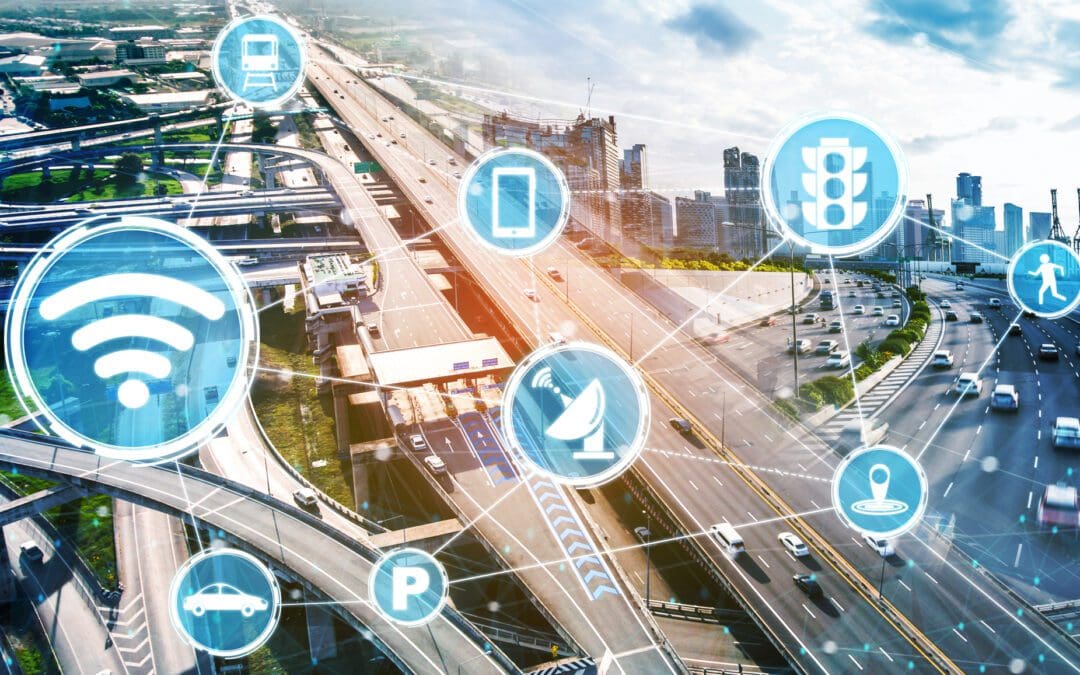The American Society of Civil Engineers explains that smart infrastructure uses sensors, cameras, and other connected devices to collect information that helps provide better public services. It works in security, traffic, public transportation, utilities, air quality, and other public services.
The increased prevalence of sensor and camera-based data collection has given rise to “smart cities,” which use sensor systems for more than data collection. They feed information into automated platforms that can use data to make real-time adjustments, improving safety and efficiency.
Some systems, such as CCTV cameras and facial recognition software, are more controversial, even though the overall goal of using them is better public safety.
Here are seven areas where smart infrastructure can improve safety and the complications and controversies that could arise from their use.
Traffic Flow
Smart infrastructure can improve traffic flow at specific intersections or city-wide. Smart sensors communicate with traffic and vehicle computers, sending data to centralized databases.
Smart traffic lights ease congestion at specific intersections by counting vehicles and traffic flow with sensors or cameras. The system then adjusts the length of stop lights to ensure an optimal flow and reduce wait times.
A 2022 study in Egypt on smart traffic scheduling showed that a similar system might work on a larger scale. A simulation of an urban traffic control (UTC) system found a 25.98% reduction in wait times.
Autonomous vehicles (self-driving cars) can also rely on smart sensors to adjust speed and keep traffic flowing as efficiently as possible. These vehicles could potentially interface with the city’s infrastructure platform to provide information for system-wide efficiency.
The consequences of a failed smart traffic system can be severe. A malfunction in a stop light’s timing system could cause rear-end accidents. Even if the damage is limited in such collisions, it could still result in whiplash or back injuries. These injuries could have a lasting impact on victims’ lives.
For now, the most advanced technologies are tested via computer simulations, meaning cities have not yet deployed them in real situations.
IoT
The Internet of Things (IoT) refers to equipment and devices with embedded computer systems. The IoT includes many products, such as refrigerators, thermostats, watches, and manufacturing machinery.
Rather than collecting data over days or months, IoT allows instant communications and real-time improvements. For instance, a fire alarm can detect smoke, alert authorities, and trigger a suppression system.
Vehicles rely on IoT sensors. Autonomous vehicles collect data from different sources and use it to navigate safely. Many other cars have accident avoidance systems that apply the brakes or steer when an accident is imminent.
The danger is that these systems malfunction or that drivers over-rely on them and take their eyes off the road. The inattention could cause a significant accident, like a T-bone collision. Onboard sensors may fail to see non-cars on the road, leading to motorcycle accidents. Even if you don’t use these systems in your car, you might experience an Uber accident if the driver turns on autonomous systems.
Privacy
Privacy worries have been an issue since CCTV cameras became part of urban security infrastructure. Since smart infrastructure relies on massive amounts of data, including personal information, it magnifies these concerns.
The good news for citizens is that proposed legislation in the American Data Privacy and Protection Act would limit how cities could use data and would require them to maintain citizen anonymity if they pass on data to a third party. It could also mandate external audits of systems and algorithms to ensure total transparency.
An article in the University of Michigan’s Journal of Law and Mobility suggests that anonymized data can help ensure privacy while giving smart systems the information they need.
Security
CCTV cameras, license plate readers, surveillance drones, and alarm systems can help improve security in cities and reduce crime rates. Studies have shown that CCTV is somewhat effective, with a study by the City University of New York (CUNY) finding a 13% decrease in crime in areas covered by cameras.
The technology can also assist individuals. For instance, smart tags can help you locate your possessions if they get lost or stolen, and remote engine shutoff can stop thieves from driving a vehicle.
A survey of experts by Berkeley’s Center for Long-Term Cybersecurity revealed a potential drawback to these systems. The survey takers expressed concerns about hackers accessing sensitive data, including video feeds and personal identification information.
Resource Conservation
Smart systems can improve energy efficiency and reduce the use of resources like water. According to SmartGrid.gov, tech-enhanced electrical grids can reduce energy consumption through a more efficient transmission of electricity and the addition of customer-owned wind and solar systems.
Meanwhile, smart water meters and sensors within the water supply system can limit loss through leakage by notifying technicians when they detect a leak and using water flow data from sensors in the system to define where the leak occurred.
Connected grids and utilities are a target for hackers. Enemy states have been behind some attempts to shut down electrical grids, and the system is also vulnerable to non-state actors like terror groups. The same risks apply to water supply as well.
Resource Management
Smart infrastructure can help manage resources to ensure balanced distribution and protect against unsustainable overuse.
The Institute of Electrical and Electronics Engineers (IEEE) points out that smart grids can measure demand through the system and balance energy distribution to ensure everyone has access to the electricity they need.
Smart sensors could ensure equal access, and they could also manage the quality of the resources. For instance, sensors can assess water quality to ensure city residents have safe drinking water.
Finally, smart systems allow two-way communications. Automated meters ensure accurate readings, and people with home solar panels can feed energy into the electrical grid and automatically get credit for doing so. The process is known as net metering.
One of the biggest problems is that the U.S. power grid uses outdated systems incompatible with IoT sensors. Also, the system is vulnerable to cyber crimes. For instance, criminals or bad actors inside electrical companies could engage in false metering to overbill customers and pocket the difference.
Sensor-Based Alerts
Sensor-based alerts can notify utility providers, law enforcement, first responders, or other relevant agencies when a malfunction, accident, or security breach occurs. IoT sensors can transmit data in real time, providing immediate notifications and speeding up response times.
These alerts could be life-saving in the event of a contaminated water supply or fire. IoT sensors are sometimes equipped to automatically take the first step themselves. For instance, they could automatically switch a traffic signal to a flashing red light when there is a malfunction or burned-out light.
An over-reliance on sensors could leave some problems undiscovered or a malfunction could cause dangerous situations. For instance, malfunctioning sensors controlling “don’t walk” signals at a crosswalk could cause pedestrian accidents or bicycle collisions. Even at low speeds, these incidents could lead to broken bones or concussions.
If a smart system malfunctions, the operator could be partially liable. For instance, in a car accident caused by faulty smart traffic signals, you could pursue a settlement from the city or state responsible for the signals.


